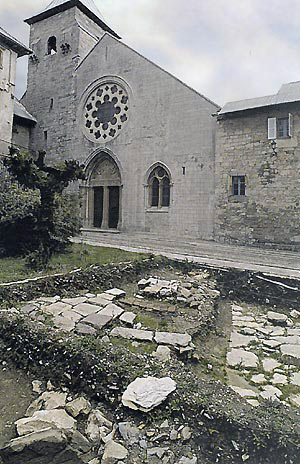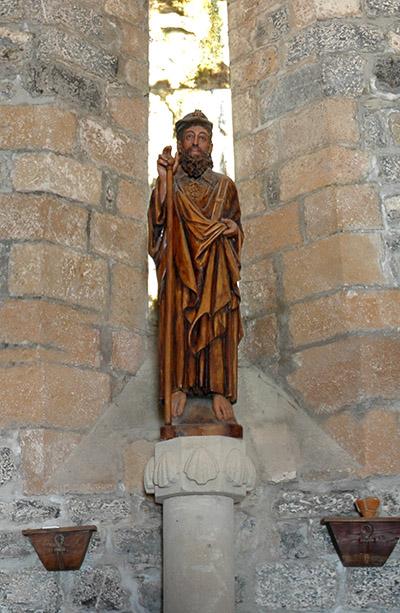
After passing through Ultrapuertos, leaving the Pyrenean behind, Orreaga- Roncesvalles signifies for the pilgrim, the door to the last stretch of the Way, although there are 700 km left to reach the goal. The pilgrims consider it the second main point of the Jacobean Way, after the cathedral of Compostela, due to the historic and symbolic strength of the artistic collection there.
Roncesvalles
and The Jacobean Way
The origins of the Santiago’s Way
The worship of James and the veneration of his human remains began in the early 9th century, but we do not exactly know when the pilgrimages started. There are some indications that connect Orreaga- Roncesvalles with Galicia and Asturias from the beginning of the 9th century, although it would not be until the 10th century, when the transit of pilgrims was safer, thanks to the Christian monarchy.
The consolidation and the “new design” of the Jacobean Way, which would be fixed for the posterity has been attributed to Sancho III el Mayor (1004- 1035). But nowadays, we know without a doubt, that Sancho Garcés I (905- 925) secured the Jacobean Way that goes through the old Roman road to Pamplona from Nájera, continuing to the west, following “the way of the stars”. At the same time he organised a Christian monarchy, which aimed at the expense of the Moslems, he was also very interested in cultivating relations with other Christian territories in the peninsula.

The first hospitals
The pilgrims needed a place to rest, after the difficult ascent of the Pyrenean routes. For that reason, a small monastery- hospital, dedicated to Saint Salvador, on the top of the Ibañeta and which was managed by the Monastery of Leire, exist since the 11th century.
The phenomenon of the Jacobean pilgrimage, was becoming even more important, and it did not make sense for the bishop of Pamplona, as head of the Church in Navarra, to alienate himself from the entry of pilgrims to this diocese. In 1127, the bishop Sancho de Larrosa, decided to create a fraternity of lay people and ecclesiastics, who managed the new hostel near Orreaga- Roncesvalles.
But the fraternity was not enough, and in 1135 a Collegiate of canons, presided by the prior Sancho, took charge of the hospital. The founder bishop gave them the incomes that were coming from the valleys nearby, as a basis for an economic and social space, which as time went by, crossed the boundaries of the kingdom. In 1137, the Pope Honorio II confirmed the creation of the chapter and its first endowment; the last step was given.
Liber Sancti Jacobi
One of the essential elements in the spreading of the worship of James, in the age of the crusades, which could have distracted the attention to other centres of pilgrimage like Rome or Jerusalem, was the famous “Liber Sancti Jacobi”, written in 1440, without a doubt, by a French pilgrim.
The Liber constitutes a direct testimony of the medieval pilgrimage and it blends several stories together, related in the Jacobean tradition, in addition to other religious and liturgical texts. At the same time, it includes a famous Medieval Pilgrim Guide, possibly written by Aimerico Picaud. The content of this text, read and sung a thousand times, describes the route with the experience of someone who has covered it more than once. He knows Navarra very well, and we have to admit that he also shows his lack of sympathy for the people who live there, and for the landscape, which is presented as inhospitable and closed.
The “Poema de Roncesvalles” o “Chanson de Roland”, included in the codex “La Pretiosa” of the 13th century, are also very famous.These give a very different view of the welcoming conditions in the hostel from Aimerico Picaud. It was said that the door was open for Christians and pagans, rich and poor, with no distinctions at all. The walkers could have a bath and have their shoes repaired. The sick people received the best attention and were treated with best medicine. They could rest in clean and soft beds, attended by pretty and honest women. The hospital offered 5 meals a day, which included bread, wine and meat, and the walkers could stay in the hostel three nights minimum.

located next to the “Silo de Carlomagno”.
Santiago in Roncesvalles
After passing through Ultrapuertos, leaving the Pyrenean behind, Orreaga- Roncesvalles signifies for the pilgrim, the door to the last stretch of the Way, although there are 700 km left to reach the goal. The pilgrims consider it the second main point of the Jacobean Way, after the cathedral of Compostela, due to the historic and symbolic strength of the artistic collection there.
The small and simple gothic chapel located next to the “Silo de Carlomagno”, is the only building in Orreaga- Roncesvalles, which honours the worship of St. James. The pilgrimage to Compostela and the Carolingian world, are the central purposes of Orreaga- Roncesvalles.
